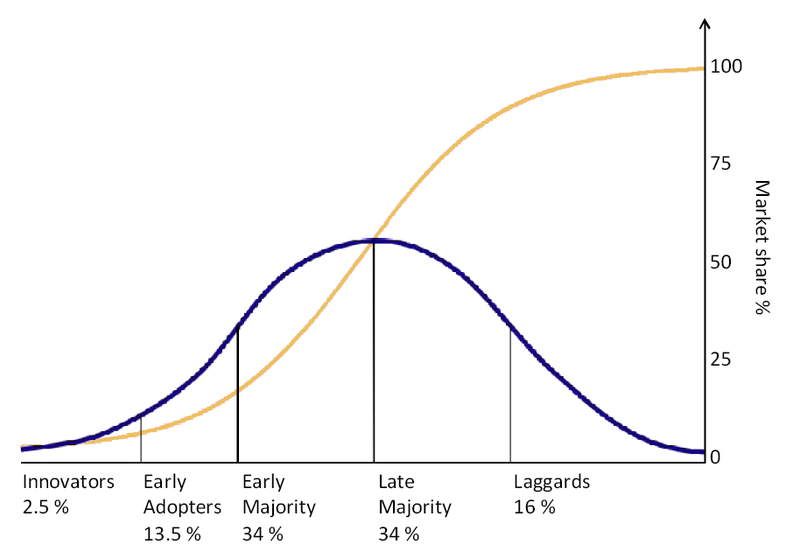The concept of innovation has been on the forefront of business’s minds with every minor advancement in technology that hits the marketplace. Since businesses aim to remain at the top of their market sector, they are continually facing the dilemma of diffusion of innovations, which is the rate of adoption [and] spread of innovation in the social system through communication via particular channels-influential individuals, related businesses social networks (Flew, 2008). The obstacle marketing agencies and employees have to overcome relating to the diffusion of innovations is being able to properly predict which technologies will be the most beneficial in effective communication and profitability, as well as adopting these new and advancing technologies as rapidly as their customer’s demand them.
Before marketing professionals and companies adopt new channels to market, they have to extensively research and consider the advantages, and potential challenges, to each new marketing opportunity. As seen in many circumstances, becoming the first to adopt a new piece of technology, can dictate the success, or failure, of a company down the road. The problem however is, that marketers have to know what pieces of technology, for example, social media websites, consumers use and somehow convert that knowledge into marketing strategy to either increase sales, maintain their current customers, gain new customers or explain a new way to use their product or service. Unfortunately marketers face another dilemma trying to predict what will be the new innovative ways they can communicate messages with society. David Norman discovered and labeled what is known as the technology S-curve, which can relate to the diffusion of innovations. Adoption of new methods in the beginning, related to social media marketing in this scenario, is typically slow, because marketers can not predict the future and know that one social media platform will be used more, or will be more effective, than another. This only adds to the challenges that marketers incur; they want to be ahead of the game, but it is challenging to know what new forms of communication will be adopted by consumers and other marketing professionals. Since profitability is key, a marketer does not want to waste time using a new method of communication, when it may not be the most effective form. As seen in the chart below (“Wikipedia.com,” 2009), the majority, about 64 percent, are the mainstream and late adopters, who lie in the middle (Flew, 2008).
http://en.wikipedia.org/wiki/File:Diffusionofideas.PNG
This provides statistical evidence for the dilemma faced by marketers; if they use a new form of communication, they may not know if the communication will be effective or not until they have already invested a significant amount of time and funds into it, since others may not adopt new methods as rapidly as they are.
Once marketers have decided their new strategies they wish to adopt, they have to then use such methods quickly and appropriately to satisfy consumer demands. According to Moore’s Law, [the diffusion of innovations] does not actually define the rate … but rather how fast [something is] demanded.” (Malone, 2011). Businesses, like marketers, have to be able to listen to what their consumers are demanding and act accordingly. For example, many industry professionals are now “tweeting,” on Twitter and publishing blogs about the most recent industry news. It has been said that social media platforms are, “the marketing of the future,” (Engle, 2009). With this key insight, businesses have been responding to the demand for a larger presence on social media webpages and have become users of Twitter, Facebook and blogging websites to stay connected to their consumers. Businesses are working with their strengths and listening to their customers, overcoming what is known as the innovators dilemma (Flew, 2008). Companies have numerous new social media marketing channels to choose from, but the key is to choose which will be the most effective to communicate with their desired target market and target audience. By keeping up with what consumers are demanding via internet marketing channels, they can show their customers that they are at the top of their industry.
No matter the industry, a company must evolve and quickly adapt to consumer needs and demands. Businesses, such as marketing agencies, have to listen and observe the way in which the marketplace is shifting and adjust their business plans to fit these changes demanded by consumers. For now, marketers may feel comfortable using social media platforms to communicate messages, but the question others, among myself now ponder is, what will be next?
References:
Engle, Erika. (2009, August 23). Twitter is business and marketing tool for realtor. . Retrieved from http://proquest.umi.com.ezproxy.bond.edu.au/pqdlink?vinst=PROD&fmt=3&startpage=-1&vname=PQD&did=1842032231&scaling=FULL&vtype=PQD&rqt=309&TS=1327920052&clientId=21143
Flew, Terry. (2008). New media: An introduction. (3 ed., pp. 207-210). Victoria, Australia: Oxford University Press.
Malone, Michael S. (2011, May 08). Moore’s law lives: the future is still alive [Web log message]. Retrieved from http://www.freerepublic.com/focus/bloggers/2717143/posts
Wikipedia.com. (2009, December 10). Retrieved from http://en.wikipedia.org/wiki/File:Diffusionofideas.PNG
